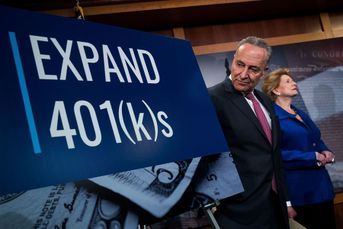Cure the harm Trump administration caused savers

Data suggest that the adoption of the SEC’s vague Regulation Best Interest and the abandonment of a strengthened DOL standard for retirement accounts have already cost savers billions of dollars in lost returns.
As the Biden administration appoints a new set of “sheriffs” to protect American investors, the first order of business should be undoing the harm to savers’ retirement accounts inflicted by two Trump Administration initiatives: the abandonment of a strengthened fiduciary duty standard for retirement accounts, and the Trump Securities and Exchange Commission’s adoption of a vague, tick-the-box Regulation Best Interest governing brokers and investment advisers’ obligations to their clients.
Data suggest that both of these Trump legacies have already cost savers billions of dollars in lost returns. The Biden Administration’s decision to apply a form of the fiduciary standard to 401(k) rollovers, which took effect Feb. 16, could mark a step in the right direction, but only if agencies and courts interpret the existing standards aggressively.
Exhibit A for the harm to savers? Variable annuities, a retirement product that costs more than cheaper mutual funds, but that is often pitched to savers for its purported tax benefits. Advisers earn commissions as high as 10% for peddling north of $100 billion in new policies annually.
A recent study published by researchers at Harvard and NYU shows that after the Department of Labor proposed the strengthened fiduciary duty rule in 2016, sales of variable annuities dropped by 19%, presumably because brokers and advisers were more afraid to sell them.
Even more striking, sales of high-priced and poorly performing versions of these products fell by 52%, resulting in what the authors calculate was a close to 1% (92 basis point) annual increase in risk-adjusted returns for savers who bought these products. Apply that 1% to the $2 trillion in variable annuity assets under management and one could conceivably put $20 billion more money yearly in retirement savers’ pockets.
Sales of variable annuities started to tick up again in 2019, suggesting that as the memory of the strengthened fiduciary duty rule fades, advisers will increasingly return to pushing these less-than-best products.
What about Regulation Best Interest, whose transition period ended this past June?
For the subsequent September quarter, “buffered” or “structured” annuities became one of the fastest growing SEC-registered retirement saving products, with sales up 38.1% year-over-year, to a $24 billion annual run rate.
These fiendishly complex products, which presumably can satisfy Regulation Best Interest, have low to zero explicit fees, making them easier to sell to savers who are increasingly wary of high-fee products.
So how do financial firms and insurance companies make their money on these products, which “insure” investors for a certain amount of stock market downside? Often, by linking savers’ returns to the price change, but not the dividends paid by the companies in a stock market index. The financial sponsor effectively keeps the dividends for itself — a fact generally not emphasized in sales literature for these products.
The result? Buffered annuities are sometimes overpriced by 10% to 15% based on the value of their embedded options, and may offer significantly lower returns than safer “insurance” against market downside that can be had by owning a combination of certificates of deposits and stocks.
Some argue that high fees, fat commissions and less-than-best recommendations from advisers are a lesser evil than the danger of investors not getting any advice at all. Put another way, allowing advisers to sneak a few extra dollars out of savers’ wallets is the price one needs to pay to get mediocre advice to savers — advice that is better than no advice.
The Harvard/NYU study attacks that argument, suggesting that the upside lost to investors who dropped out of annuities is a fraction of the upside gained by those who moved to better investments.
Now is a golden age for low-cost investments. There is no shortage of cost efficiencies in providing advice, and fintech firms eager to reap them. The way to ensure savers’ benefit is to put in place strong fiduciary duty and Best Interest regulations that force those who exploit complexity and ignorance out of the business, so that savers get their maximum share of investment rewards.
[More: 401(k) fees are eating Americans’ retirement savings]
Ethan Schwartz has worked as an investment manager and financial services executive for 21 years. He was special assistant to the deputy secretary of the Treasury in the Clinton administration.
Learn more about reprints and licensing for this article.








